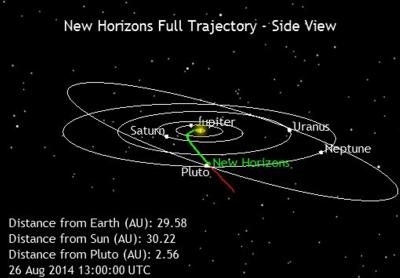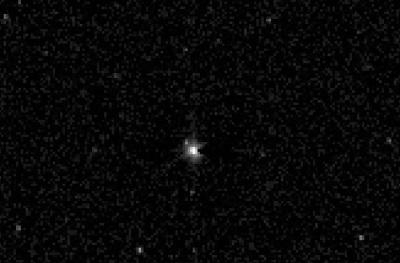Probe En Route To Historic Encounter With Pluto
NASA's Pluto-bound New Horizons spacecraft has traversed the orbit of Neptune. This is its last major crossing en route to becoming the first probe to make a close encounter with distant Pluto on July 14, 2015.

The sophisticated piano-sized spacecraft, which launched in January 2006, reached Neptune's orbit -- nearly 2.75 billion miles from Earth -- in a record eight years and eight months. New Horizons' milestone matches precisely the 25th anniversary of the historic encounter of NASA's Voyager 2 spacecraft with Neptune on Aug. 25, 1989.
"It's a cosmic coincidence that connects one of NASA's iconic past outer solar system explorers, with our next outer solar system explorer," said Jim Green, director of NASA's Planetary Science Division, NASA Headquarters in Washington. "Exactly 25 years ago at Neptune, Voyager 2 delivered our 'first' look at an unexplored planet. Now it will be New Horizons' turn to reveal the unexplored Pluto and its moons in stunning detail next summer on its way into the vast outer reaches of the solar system."
New Horizons now is about 2.48 billion miles from Neptune -- nearly 27 times the distance between the Earth and our sun -- as it crosses the giant planet's orbit at 10:04 p.m. EDT Monday. Although the spacecraft will be much farther from the planet than Voyager 2's closest approach, New Horizons' telescopic camera was able to obtain several long-distance "approach" shots of Neptune on July 10.
"NASA's Voyager 1 and 2 explored the entire middle zone of the solar system where the giant planets orbit," said Alan Stern, New Horizons principal investigator at the Southwest Research Institute in Boulder, Colorado. "Now we stand on Voyager's broad shoulders to explore the even more distant and mysterious Pluto system."
Several senior members of the New Horizons science team were young members of Voyager's science team in 1989. Many remember how Voyager 2's approach images of Neptune and its planet-sized moon Triton fueled anticipation of the discoveries to come. They share a similar, growing excitement as New Horizons begins its approach to Pluto.

"The feeling 25 years ago was that this was really cool, because we're going to see Neptune and Triton up-close for the first time," said Ralph McNutt of the Johns Hopkins University Applied Physics Laboratory (APL) in Laurel, Maryland, who leads the New Horizons energetic-particle investigation and served on the Voyager plasma-analysis team. "The same is happening for New Horizons. Even this summer, when we're still a year out and our cameras can only spot Pluto and its largest moon as dots, we know we're in for something incredible ahead."
New Horizons is the first mission in NASA's New Frontiers program. APL manages the mission for NASA's Science Mission Directorate at NASA Headquarters. APL also built and operates the New Horizons spacecraft.
The Voyager spacecraft were built and continue to be operated by NASA's Jet Propulsion Laboratory in Pasadena, California. The Voyager missions are part of NASA's Heliophysics System Observatory, sponsored by the Heliophysics Division of the Science Mission Directorate.
(NASA images. Top: New Horizons' trajectory through the solar system. Bottom: Neptune photographed by New Horizons spacecraft)
 ANN's Daily Aero-Term (05.01.24): Say Altitude
ANN's Daily Aero-Term (05.01.24): Say Altitude ANN's Daily Aero-Linx (05.01.24)
ANN's Daily Aero-Linx (05.01.24) Classic Aero-TV: Korean War Hero Twice Reborn
Classic Aero-TV: Korean War Hero Twice Reborn Airborne 04.29.24: EAA B-25 Rides, Textron 2024, G700 Deliveries
Airborne 04.29.24: EAA B-25 Rides, Textron 2024, G700 Deliveries Airborne Affordable Flyers 05.02.24: Bobby Bailey, SPRG Report Cards, Skydive!
Airborne Affordable Flyers 05.02.24: Bobby Bailey, SPRG Report Cards, Skydive!




